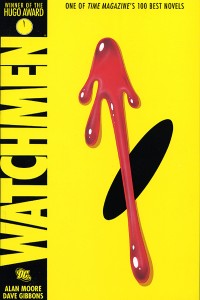Watchmen, a graphic novel by Alan Moore and Dave Gibbons, is a story about ordinary people with an extraordinary urge to uphold justice. The catch is that they all started out as everyday citizens who are, by no means, perfect. This means that their beliefs and values are embedded into everything that they do, resulting in a story about the anti-hero. For example, Rorschach, the first vigilante we are introduced to, puts the law above all else, making him incapable of adapting to novel situations where advocating the law may not be the best choice.
But why do people love Watchmen? This novel embodies the very worst of human nature through its harsh illustrations of corpses, criminals and anti-heroes. Upon encountering this novel, I was close to giving up by the end of the first chapter. Why would I want to read about all this misery when the horrors of the human race is already evident everywhere and ready to jump at you when you asked for it? As I powered on through the book, somewhere near the middle of it, everything was suddenly so intriguing. I was familiar with the characters and the situation at hand by then and so, I could fully engage with the story. I felt like I was getting an inside scoop on some secret conspiracy and when comparing it to the real world around me, I would go as far as to say that there was truth in what was being said in the story.
One aspect of the novel which caught my attention was the way that global issues and ideas were represented through the characters. In class, we discussed how Dr Manhattan, the story’s only true ‘super’ hero with abnormal powers, could be seen to portray America as a feared nuclear power during the 1980s. A news broadcaster says “The superman exists, and he’s American” (Moore, 4.13) to announce the arrival of Dr Manhattan which seems to reflect America as a superpower. An other identity that Dr Manhattan is associated with is that of God. He can see into the doomed future of humanity but does nothing to change it. At first glance, the message behind this may be one along the lines of claiming that if there is a God, he does not care for the human race. My interpretation of it is as follows: perhaps to God, every particle in existence is just as important as the next. In other words, a rock is no different to a human being because fundamentally, they both share the same particles. This way of thinking gives no reason for a God to worry about what happens to humanity. The apocalypse is merely a rearrangement of particles in space.
Time portrayal in Watchmen was another interesting aspect. The rearrangement of time can be seen most clearly through Dr Manhattan’s point of view when we learn more about him in chapter 4. As he recalls his past, his narration includes facts of the future soon to come, as if all these events are happening simultaneously. Portraying time in this complex way is something that few medium can achieve including graphic novels and movies. Thankfully, there is also a movie of this book which helped to clear up any confusion I had whilst reading the book.
To conclude, I highly recommend this book to anyone who is looking for a change-up in what they normally read. After reading the book, go ahead and watch the movie – I was pleasantly surprised at how true the movie stayed to the original plot.

Sources:
Moore, Alan, and Dave Gibbons.Watchmen. Book club ed. New York: DC Comics Inc., 19871986. Print.